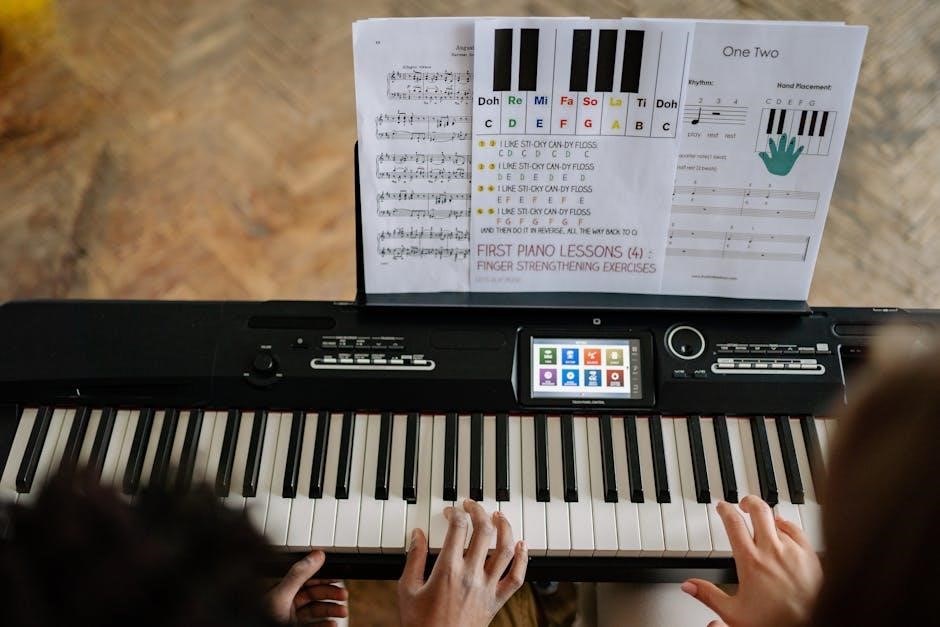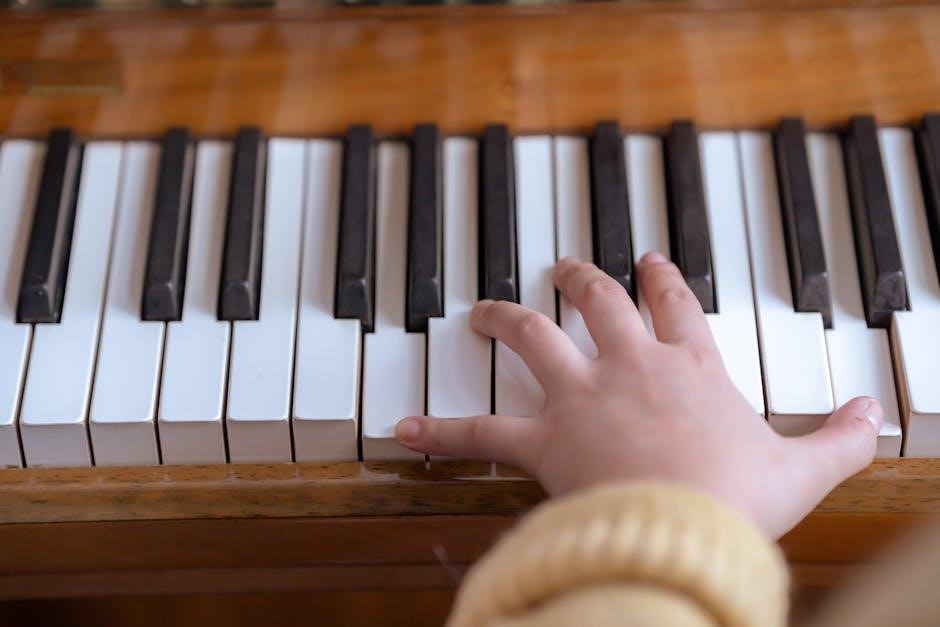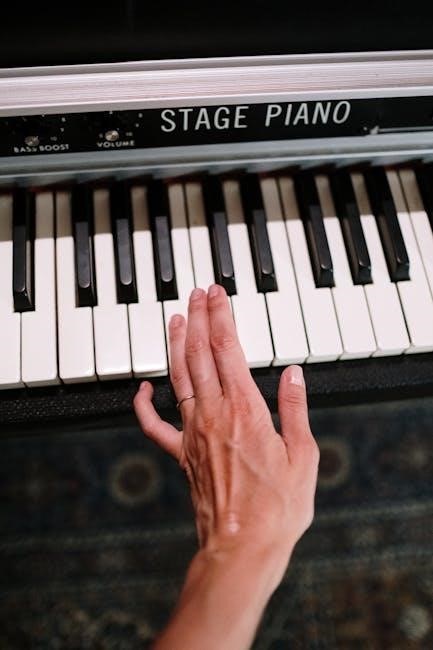Learning piano finger position requires patience and practice with piano finger position pdf guides and online resources available to help beginners master proper hand placement and finger placement techniques effectively always.
Understanding the Basics of Finger Placement
To understand the basics of finger placement, it is essential to start with the fundamentals of piano playing, including the proper hand position and finger numbering, which can be found in various piano finger position pdf guides available online. These resources provide detailed information on how to place fingers on the keys, including the correct curvature of the fingers and the placement of the wrists. Additionally, online tutorials and videos can help demonstrate the proper finger placement techniques, making it easier for beginners to learn and practice. By mastering the basics of finger placement, piano players can improve their overall technique and develop good playing habits, which are crucial for progressing to more complex pieces and repertoire. With consistent practice and dedication, anyone can learn to play the piano with proper finger placement and technique.

Importance of Proper Hand Position
Proper hand position is crucial for comfortable playing with piano finger position pdf guides helping to achieve optimal technique always.
Benefits of Natural Hand Position for Efficient Playing
The benefits of natural hand position for efficient playing are numerous, with piano finger position pdf guides providing valuable insights into optimal technique. By adopting a natural hand position, pianists can reduce fatigue, improve dexterity, and enhance overall performance. This, in turn, allows for more expressive and nuanced playing, as the hands are able to move freely and effortlessly across the keyboard. Furthermore, a natural hand position helps to prevent injuries and strain, enabling pianists to practice and perform for extended periods without discomfort. With the help of piano finger position pdf resources, pianists can develop a deeper understanding of proper hand positioning and enjoy the many benefits it brings to their playing. Effective hand position is essential for efficient playing, and with practice, pianists can develop the skills and techniques needed to achieve mastery.

Rules for Effective Piano Fingering
Follow seven rules for effective piano fingering with piano finger position pdf guides to achieve beautiful sound and efficient playing techniques always correctly.
Creating Personalized Fingerings for Beautiful Sound
To create personalized fingerings for beautiful sound, pianists should consider their individual hand shape and finger length, as no two hands are alike, and utilize piano finger position pdf guides to help develop effective techniques. By doing so, they can produce a more natural and expressive sound. This approach also allows for greater flexibility and adaptability when playing complex pieces. Additionally, pianists can experiment with different fingerings to find the most comfortable and efficient way to play, which can lead to improved overall performance. With the help of online resources and guides, pianists can develop their own unique fingerings and improve their sound quality. This personalized approach to fingering can make a significant difference in the beauty and expressiveness of the music, and is an important aspect of piano playing to master, using available piano finger position pdf materials.

Piano Fingering for Scales and Melodies
Mastering scales and melodies requires proper piano finger position pdf techniques and consistent practice always effectively.
Using Finger Turns for Comfortable and Easy Execution
To achieve comfortable and easy execution of piano pieces, it is essential to use finger turns effectively, as mentioned in various piano finger position pdf guides. Finger turns allow pianists to play complex melodies and scales with ease, reducing fatigue and strain on the hands. By mastering finger turns, pianists can improve their overall technique and produce a more beautiful sound. This technique is particularly useful when playing scales and arpeggios, as it enables pianists to maintain a smooth and even tone. With consistent practice and dedication, pianists can develop the skills necessary to execute finger turns with ease and precision, taking their playing to the next level. Effective use of finger turns is a crucial aspect of piano playing, and with the right guidance and practice, pianists can master this technique and enhance their overall performance.

Blues Scales Piano Right Hand Fingering
Learn blues scales piano right hand fingering with piano finger position pdf guides and online resources for efficient playing techniques always.
Minor and Major Blues Scales Fingerings and Examples
Minor and major blues scales fingerings are essential for piano players, with piano finger position pdf guides providing valuable resources. The minor blues scale consists of a specific pattern of whole and half steps, and understanding this pattern is crucial for playing blues music. Major blues scales, on the other hand, have a distinct sound and require different fingerings. Examples of minor and major blues scales can be found in various online resources, including piano finger position pdf files. These resources often include diagrams and illustrations to help players learn the correct fingerings and hand positions. By practicing minor and major blues scales, piano players can improve their technique and develop a deeper understanding of blues music, enabling them to play with more expression and feeling, using the correct fingerings always.
Mastering Scale Fingerings with Diagrams and Tools
Utilizing piano finger position pdf diagrams and tools enhances scale fingering mastery effectively always online.
Strategies for Remembering and Practicing Fingerings
Practicing piano fingerings requires a combination of physical practice and mental memorization, with resources like piano finger position pdf guides providing a solid foundation for learning. One effective strategy is to break down complex pieces into smaller sections, focusing on mastering one section at a time. Placing diagrams in the back of assignment books with fingerings for all scales can also be helpful. Additionally, using tools like flashcards or apps can aid in memorization. It is also important to practice slowly and deliberately, increasing speed as fingerings become more comfortable. By incorporating these strategies into daily practice, pianists can improve their ability to remember and execute complex fingerings with ease, leading to more confident and expressive performances. Regular practice and review are essential to reinforcing new skills and preventing forgetting.
Piano Technique and Finger Independence
Developing finger strength and dexterity with piano finger position pdf guides enhances overall piano technique and finger independence always.
Developing Finger Strength and Dexterity for Advanced Playing
Developing finger strength and dexterity is crucial for advanced piano playing, and utilizing piano finger position pdf guides can be beneficial. These resources provide exercises and techniques to enhance finger independence, strength, and agility. By practicing regularly with these guides, pianists can improve their overall technique and master complex pieces. The internet offers a wide range of piano finger position pdf documents, including those specifically designed for advanced players. These documents often include finger exercises, scales, and arpeggios to help pianists develop the necessary strength and dexterity for advanced playing. With consistent practice and dedication, pianists can achieve a high level of technical proficiency and express themselves more effectively through music, making piano finger position pdf guides a valuable resource for those seeking to improve their skills. Regular practice is essential to achieve desired results.